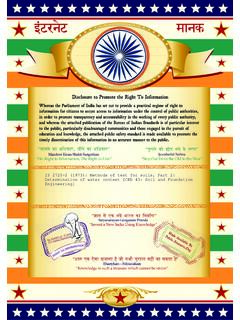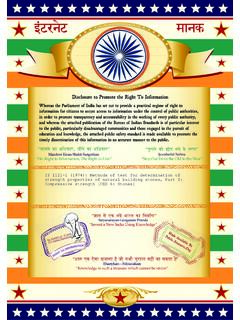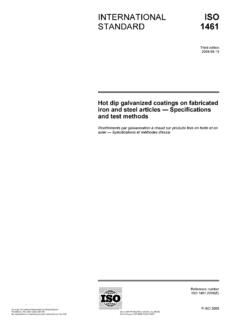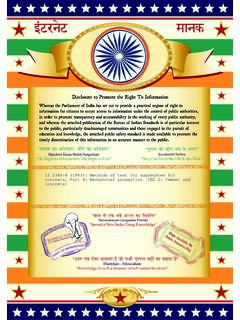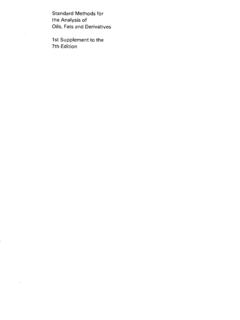Transcription of Standard Test Methods for Determining Average Grain Size1
1 Designation: E112 10 Standard Test Methods forDetermining Average Grain Size1 This Standard is issued under the fixed designation E112; the number immediately following the designation indicates the year oforiginal adoption or, in the case of revision, the year of last revision. A number in parentheses indicates the year of last reapproval. Asuperscript epsilon ( ) indicates an editorial change since the last revision or Standard has been approved for use by agencies of the Department of test Methods of determination of Average Grain size in metallic materials are primarilymeasuring procedures and, because of their purely geometric basis, are independent of the metal oralloy concerned. In fact, the basic procedures may also be used for the estimation of Average Grain ,crystal, or cell size in nonmetallic materials. The comparison method may be used if the structure ofthe material approaches the appearance of one of the Standard comparison charts.
2 The intercept andplanimetric Methods are always applicable for Determining Average Grain size. However, thecomparison charts cannot be used for measurement of individual These test Methods cover the measurement of averagegrain size and include the comparison procedure, the planimet-ric (or Jeffries) procedure, and the intercept procedures. Thesetest Methods may also be applied to nonmetallic materials withstructures having appearances similar to those of the metallicstructures shown in the comparison charts. These test methodsapply chiefly to single phase Grain structures but they can beapplied to determine the Average size of a particular type ofgrain structure in a multiphase or multiconstituent These test Methods are used to determine the averagegrain size of specimens with a unimodal distribution of grainareas, diameters, or intercept lengths. These distributions areapproximately log normal.
3 These test Methods do not covermethods to characterize the nature of these of Grain size in specimens with duplex grainsize distributions is described in Test MethodsE1181. Mea-surement of individual, very coarse grains in a fine grainedmatrix is described in Test These test Methods deal only with determination ofplanar Grain size, that is, characterization of the two-dimensional Grain sections revealed by the sectioning of spatial Grain size, that is, measurement of thesize of the three-dimensional grains in the specimen volume, isbeyond the scope of these test These test Methods describe techniques performedmanually using either a Standard series of graded chart imagesfor the comparison method or simple templates for the manualcounting Methods . Utilization of semi-automatic digitizingtablets or automatic image analyzers to measure Grain size isdescribed in Test These test Methods deal only with the recommended testmethods and nothing in them should be construed as definingor establishing limits of acceptability or fitness of purpose ofthe materials The measured values are stated in SI units, which areregarded as Standard .
4 Equivalent inch-pound values, whenlisted, are in parentheses and may be Standard does not purport to address all of thesafety concerns, if any, associated with its use. It is theresponsibility of the user of this Standard to establish appro-priate safety and health practices and determine the applica-bility of regulatory limitations prior to The paragraphs appear in the following order:SectionNumberScope1 Referenced Documents2 Terminology3 Significance and Use4 Generalities of Application5 Sampling6 Test Specimens7 Calibration8 Preparation of Photomicrographs9 Comparison Procedure10 Planimetric (Jeffries) Procedure11 General Intercept Procedures12 Heyn Linear Intercept Procedure13 Circular Intercept Procedures14 Hilliard Single-Circle Three-Circle test Methods are under the jurisdiction of ASTM CommitteeE04onMetallography and are the direct responsibility of edition approved Nov.
5 1, 2010. Published December 2010. Originallyapproved in 1955. Last previous edition approved 2004 as E112 96(2004) 2. ASTM International, 100 Barr Harbor Drive, PO Box C700, West Conshohocken, PA 19428-2959, United ASTM International, 100 Barr Harbor Drive, West Conshohocken, Pennsylvania 19428, USAD istributed under ASTM license agreement by Shanghai Institute of Standardization (SIS) Tel: 86-21-64370807 ASTM International , 100 Barr Harbor Drive, West Conshohocken, Pennsylvania, 19428, USA SIS ASTM : 1219/1227 : 200031 : 86-21-64370807 Statistical Analysis15 Specimens with Non-equiaxed Grain Shapes16 Specimens Containing Two or More Phases or Constituents17 Report18 Precision and Bias19 Keywords20 Annexes:Basis of ASTM Grain Size NumbersAnnexA1 Equations for Conversions Among Various Grain Size MeasurementsAnnexA2 Austenite Grain Size, Ferritic and Austenitic SteelsAnnexA3 Fracture Grain Size MethodAnnexA4 Requirements for Wrought Copper and Copper-Base AlloysAnnexA5 Application to Special SituationsAnnexA6 Appendixes:Results of Interlaboratory Grain Size DeterminationsAppen-dix X1 Referenced AdjunctsAppen-dix X22.
6 Referenced standards :2E3 Guide for Preparation of Metallographic SpecimensE7 Terminology Relating to MetallographyE407 Practice for Microetching Metals and AlloysE562 Test Method for Determining Volume Fraction bySystematic Manual Point CountE691 Practice for Conducting an Interlaboratory Study toDetermine the Precision of a Test MethodE883 Guide for Reflected Light PhotomicrographyE930 Test Methods for Estimating the Largest Grain Ob-served in a Metallographic Section (ALA Grain Size)E1181 Test Methods for Characterizing Duplex Grain SizesE1382 Test Methods for Determining Average Grain SizeUsing Semiautomatic and Automatic Image For a complete adjunct list, seeAppendix X23. For definitions of terms used in these testmethods, see of Terms Specific to This Grain size number the ASTM Grain sizenumber,G, was originally defined as:NAE52G21(1)whereNAEis the number of grains per square inch at 100 Xmagnification.
7 To obtain the number per square millimetre at1X, multiply by that area within the confines of the original(primary) boundary observed on the two-dimensional plane-of-polish or that volume enclosed by the original (primary)boundary in the three-dimensional object. In materials contain-ing twin boundaries, the twin boundaries are ignored, that is,the structure on either side of a twin boundary belongs to boundary intersection count determination ofthe number of times a test line cuts across, or is tangent to, Grain boundaries (triple point intersections are considered as1-1 2intersections). intercept count determination of the number oftimes a test line cuts through individual grains on the plane ofpolish (tangent hits are considered as one half an interception;test lines that end within a Grain are considered as one half aninterception). length the distance between two opposed,adjacent Grain boundary intersection points on a test linesegment that crosses the Grain at any location due to randomplacement of the test :Symbols:a= matrix grains in a two phase (constituent) test = mean Grain cross sectional ,= Grain elongation ratio or anisotropy indexfor a longitudinally oriented = mean planar Grain diameter (Plate III).
8 D = mean spatial (volumetric) Grain Jeffries multiplier for planimetric ASTM Grain size number., = mean lineal intercept length., a= mean lineal intercept length of theamatrix phase in a two phase (constituent)microstructure., ,= mean lineal intercept length on a longitu-dinally oriented surface for a non-equiaxed Grain structure., t= mean lineal intercept length on a trans-versely oriented surface for a non-equiaxed Grain structure., p= mean lineal intercept length on a planaroriented surface for a non-equiaxed grainstructure.,0= base intercept length of mm fordefining the relationship betweenGand,(andNL) for macroscopically or micro-scopically determined Grain size by theintercept length of a test magnification magnification used by a chart number of fields number ofagrains intercepted by the testline in a two phase (constituent) number of grains per mm2at number ofagrains per mm2at 1X in atwo phase (constituent) referenced ASTM standards , visit the ASTM website, , orcontact ASTM Customer Service at ForAnnual Book of ASTMS tandardsvolume information, refer to the Standard s Document Summary page onthe ASTM 102 Copyright ASTM International, 100 Barr Harbor Drive, West Conshohocken, Pennsylvania 19428, USAD istributed under ASTM license agreement by Shanghai Institute of Standardization (SIS) Tel.
9 86-21-64370807 ASTM International , 100 Barr Harbor Drive, West Conshohocken, Pennsylvania, 19428, USA SIS ASTM : 1219/1227 : 200031 : 86-21-64370807 NAE= number of grains per inch2at ,=NAon a longitudinally oriented surface fora non-equiaxed Grain a transversely oriented surface for anon-equiaxed Grain a planar oriented surface for anon-equiaxed Grain number of intercepts with a test number of grains completely within a number of grains intercepted by the number of intercepts per unit length oftest ,=NLon a longitudinally oriented surface fora non-equiaxed Grain a transversely oriented surface for anon-equiaxed Grain a planar oriented surface for anon-equiaxed Grain number of Grain boundary intersectionswith a test number of Grain boundary intersectionsper unit length of test ,=PLon a longitudinally oriented surface fora non-equiaxed Grain a transversely oriented surface for anon-equiaxed Grain a planar oriented surface for anon-equiaxed Grain correction factor for comparison chartratings using a non- Standard magnifica-tion for microscopically determined correction factor for comparison chartratings using a non- Standard magnifica-tion for macroscopically determined Standard Grain boundary surface area to volumeratio for a single phase Grain boundary surface area to volumeratio for a two phase (constituent) students tmultiplier for determination ofthe confidence volume fraction of theaphase in a twophase (constituent) %CI= 95 % confidence percent relative Significance and These test Methods cover procedures for estimating andrules for expressing the Average Grain size of all metalsconsisting entirely, or principally, of a single phase.
10 The testmethods may also be used for any structures having appear-ances similar to those of the metallic structures shown in thecomparison charts. The three basic procedures for Grain sizeestimation Procedure The comparison proceduredoes not require counting of either grains, intercepts, orintersections but, as the name suggests, involves comparison ofthe Grain structure to a series of graded images, either in theform of a wall chart, clear plastic overlays, or an eyepiecereticle. There appears to be a general bias in that comparisongrain size ratings claim that the Grain size is somewhat coarser(1 2to 1 Gnumber lower) than it actually is ( ).Repeatability and reproducibility of comparison chart ratingsare generally61 Grain size Procedure The planimetric method in-volves an actual count of the number of grains within a knownarea. The number of grains per unit area,NA, is used todetermine the ASTM Grain size number,G.




